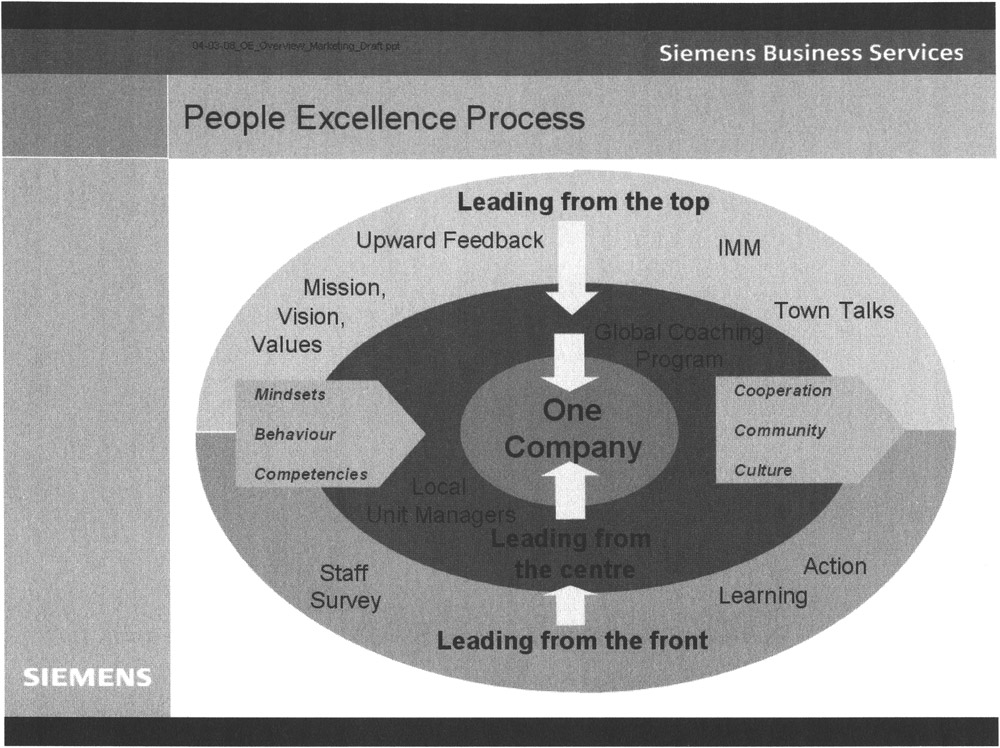Westside Toastmasters is located in Los Angeles and Santa Monica, California
CASE STUDY 1
What Examples do You Have of using Coaching to Support Change or Transform Performance?
September 2003 saw the introduction of a Global Coaching Program for first-line managers. This was part of a major change process launched in 2002, a change process with three main vectors - strategy transformation, establishment of a balanced matrix business model, and people excellence.
People excellence, as a complement and counterpart to business excellence strived for via the other two vectors, consists of four interlinked projects designed to blend leadership and involvement in a balanced form of 'distributed leadership' suited to both the balanced matrix and the network organizations of the future, especially in service companies dependent on people rather than products (see Figure 8.1).
'Leading from the top' involved the executive management team in establishing key strategic principles to guide the company over the next three to four years. This was flanked by 1,000 appreciative inquiry interviews at all levels of the organization. The interview results served as the 'dough', which 300 managers kneaded into our Mission, Vision and Values at the international management meeting in November 2002. The same managers walked the talk during 2003, both in town talks in 25 countries and in cascading workshops to anchor the vision and values in relationships and behaviour.
'Leading from the front' picked up the strategic guiding principles - strong leadership, active responsibility, intense cooperation and top performance - as the focus of a staff survey in early 2003. Six hundred reports were generated. Action learning sessions created the follow-up and implementation, leading to more than 400 actions documented in our knowledge management system.
'Leading from the center' started in November 2002 with drawing the local unit managers (ie those in the crosshairs of the matrix responsible for P&L) from 40 countries into a development community based on peer coaching and their experiences in running international and/or cross-business-unit deals. This was followed up by launching the Global Coaching Program in September 2003. In many change or transition processes, middle managers are often either overlooked or deliberately left out, since they are perceived as a source of resistance to change. Our approach was to bind them in by establishing coaching as the key leadership style in the company and developing first-line managers as the highest priority. The program (seven days, three modules, distributed over six months) focuses on personal effectiveness and performance, combined with implementing the strategy at the customer interface and living the vision and values in staff relationships.
What were the Biggest Challenges?
The biggest challenge was and is developing a common culture after eight years of constant mergers, reorganizations and acquisitions.
The second challenge was winning investment for a purely people-centered program when the company had suffered losses year on year from 1996 till 2001.
The third challenge was to make clear to top management how the four projects dovetailed to change the company culture, and to convince them that patience was important, as it would take three to five years to reap the benefits.
The final challenge was shifting the mindset of top management on coaching from a 'remedial' view, through a 'me-too, individual developmental' view to a genuine 'distributed leadership' view aimed at equipping middle managers to coach first their people and then the organization - in other words, to act as the 'transmission belt' of strategic change.
How did You Overcome These?
By engaging the executive management team in writing individually an 80-page homework book called 'Framework for Renewal', and deriving with them the strategic guiding principles as their common mindset.
By involving them in appreciative inquiry interviews - each executive interviewed five people in the organization for two hours and was interviewed by those five for two hours - to discover how to leverage the guiding principles. These two approaches led to a strong commitment to walk the talk.
By involving the entire international management (plus more than 2,000 employees via an intranet questionnaire) in establishing our vision and values.
By consistency of message, surfacing the areas for improvement related to the four guiding principles via a staff survey, which 14,000 employees took part in, and over 400 documented actions arose relating to leadership, responsibility, cooperation and performance.
By successfully forming a networked community of local unit managers to design their own development and show the advantages of peer coaching across a matrix organization.
On the basis of the above, by convincing top management that a coaching, dialogue and feedback culture is essential for success in a service and people company.
What Have been the Benefits?
Fiscal years 2002 and 2003 showed a profit for the first time in the company's eight-year history.
'Distributed leadership' is being established as a mindset throughout the company, and as the most effective and efficient way to leverage the balanced matrix.
Within this concept, coaching has come to be regarded as the core leadership style for the company, leading to piloting the Global Coaching Program for line managers from September 2003 till March 2004.
Via 360-degree feedback and other metrics, the 36 participants from 11 countries have shown measurable results in ROI with regard to productivity, quality and the bottom line.
What Advice Would You Give to Others?
As technology and price become more similar, as the options for customers and consumers increase and as cost cutting is finite if you do not want to strangle a company entirely, the importance of ROHI (return on human investment) becomes key.
Investment in people in terms of meaning, in terms of distributed leadership, in terms of values will make the difference between success and failure. Balancing sustainability and strategic flexibility, continuity and change, the cathedral and the bazaar, is the big challenge for all organizations of the future. Investing in individual and organizational coaching holds network organizations together, while allowing them to breathe with change and transition.




